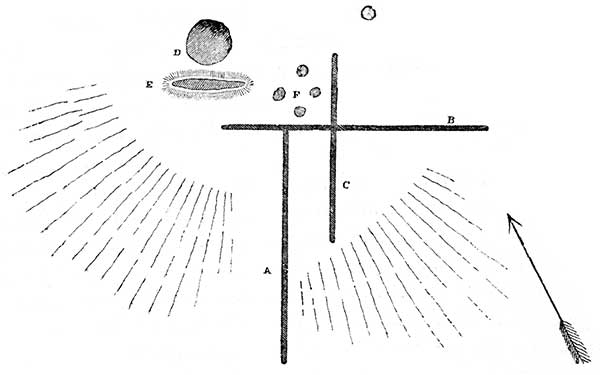CHAPTER IV
MOUNDS, BONE-HEAPS, ETC.
VARIOUS references to mounds or tumuli, resembling those found in the Valley of the Mississippi, have been made in the preceding pages. These mounds are far from numerous, and hardly deserve a separate notice. It is nevertheless an interesting fact to know that isolated examples occur, in situations where it is clear no dependence exists between them and the grand system of earth-works of the Western States. It serves to sustain the conclusion that the savage Indian tribes occasionally constructed mounds; which are however rather to be considered as accidents than the results of a general practice. The purposes of the mounds of New York, so far as can be determined, seem uniformly to have been those of sepulture. They generally occur upon commanding or remarkable positions. Most of them have been excavated, under the impulse of an idle curiosity, or have had their contents scattered by "money-diggers," a ghostly race, of which, singularly enough, even at this day, representatives may be found in almost every village. I was fortunate enough to discover one upon Tonawanda Island, in Niagara River, which had escaped their midnight attentions. It was originally about fifteen feet in height. At the base appeared to have been a circle of stones, perhaps ten feet in diameter, within which were several small heaps of bones, each comprising three or four skeletons. The bones are of individuals of all ages, and had evidently been deposited after the removal of the flesh. Traces of fire were to be discovered upon the stones. Some chippings of flint and broken arrow-points, as also some fragments of deers' horns, which appeared to have been worked into form, were found amongst the bones. The skulls had been crushed by the superincumbent earth.
The mounds which formerly existed in Erie, Genesee, Monroe, Livingston, St. Lawrence, Oswego, Chenango, and Delaware counties, all appear to have contained human bones, in greater or less quantities, deposited promiscuously, and embracing the skeletons of individuals of all ages and both sexes. They probably all owe their origin to a practice common to many of the North American tribes, of collecting together at fixed intervals the bones of their dead, and finally depositing them with many and solemn ceremonies. They were sometimes heaped together so as to constitute mounds; at others placed in pits or trenches dug in the earth; and it is probable they were in some instances buried in separate graves, but in long ranges, or deposited in caverns, either promiscuously or with regularity.
The period when this second burial took place occurred at different intervals amongst the different tribes, but was universally denominated the "Festival of the Dead." Bartram, speaking of the burial customs of the Floridian Indians, says: "After the bone-house is full, a general solemn funeral takes place. The nearest kindred and friends of the deceased, on a day appointed, repair to the bone-house, take up the respective coffins, and, following one another in the order of seniority, the nearest relations and connections attending their respective corpses, and the multitude succeeding them, singing and lamenting alternately, slowly proceed to the place of general interment, when they place the coffins in order forming a pyramid. Lastly, they cover all over with earth, which raises a conical hill or mount. They then return to town in order of solemn procession, concluding the day with a festival which is called the 'Feast of the Dead?'"13 The author here quoted adds in a note, that it was the opinion of some ingenious men with whom he had conversed, "that all those artificial pyramidal hills, usually called 'Indian Mounts,' were raised on such occasions, and are generally sepulchres;" from which opinion he takes occasion to dissent. There is no doubt a wide difference between the mounds thus formed and the great bulk of those connected with the vast ancient enclosures of the Western States.
The large cemeteries which have been discovered in Tennessee, Kentucky, Missouri, and Ohio, seem to have resulted from a similar practice. In these the skeletons were generally packed in rude coffins composed of flat stones, placed in ranges of great extent. The circumstance that many of these coffins were not more than two or three feet in length, gave rise to the notion of the former existence here of a pigmy race. The discovery of iron and some articles of European origin in one of these cemeteries in the vicinity of Augusta, Kentucky, shows that this mode of burial existed at a late period among the Indians in that direction.
The "bone-pits" which occur in some parts of Western New York, Canada, Michigan, etc., have unquestionably a corresponding origin. Several of these have been described in a previous chapter. They are of various sizes, but usually contain a large number of skeletons. In a few instances the bones appear to have been arranged with some degree of regularity.
One of these pits discovered some years ago, in the town of Cambria, Niagara county, was estimated to contain the bones of several thousand individuals. Another which I visited in the town of Clarence, Erie county, contained not less than four hundred skeletons. A deposit of bones comprising a large number of skeletons was found not long since, in making some excavations in the town of Black Rock, situated on Niagara River, in Erie county. They were arranged in a circle, with their heads radiating from a large copper kettle, which had been placed in the centre, and filled with bones. Various implements both of modern and remote date had been placed beside the skeletons.
In Canada similar deposits are frequent. Accounts of their discovery and character have appeared in various English publications, among which may be named the "British Colonial Newspaper," of September 24th, 1847, and the "Edinburgh New Philosophical Journal," for July, 1848. From a communication in the latter, by Edward W. Bawtree, M. D., the subjoined interesting facts are derived.
A quantity of human bones was found in one spot, in 1846, near Barrie, and also a pit containing human bones near St. Vincent's. Great numbers were found in the latter, with several copper and brass kettles, and various trinkets and ornaments in common use among the Indians. This discovery led to the examination of a similar pit, about seven miles from Penetanqueshene, in the township of Giny. "This pit was accidentally noticed by a Canadian while making sugar in the neighborhood. He was struck by its appearance and the peculiar sound produced at the bottom by stamping there; and, in turning up a few spadefuls of earth, was surprised to find a quantity of human bones. It was more accurately examined in September, 1847, and found to contain, besides a great number of human skeletons, of both sexes and all ages, twenty-six copper and brass kettles and boilers; three large conch-shells; pieces of beaver-skin in tolerable preservation; a fragment of a pipe; a large iron axe, evidently of French manufacture; some human hair (that of a woman); a copper bracelet; and a quantity of fiat auricular beads, perforated through the centre.
"The form of the pit is circular, with an elevated margin; it is about fifteen feet in diameter, and before it was opened was probably nine feet deep from the level of its margin to its centre and bottom; it was, in one word, funnel-shaped. It is situated on the top of a gentle rise, with a shallow ravine on the east side, through which, at certain seasons, runs a small stream. The soil is light, free from stones, and dry. A small iron-wood tree, about two inches in diameter, is growing in the centre of the pit.
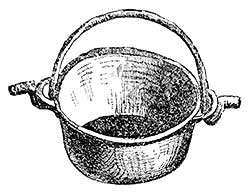
|
| Fig. 4. Copper Kettle. |
"The kettles, of which Fig. 4 is an example, resemble those in use at the present day, and appear to be formed of sheet copper, the rim being beaten out so as to cover an iron band which passes around the mouth of the vessel. The iron handle by which they were suspended hooks into eyes attached to the band above mentioned. The smallest holds about six gallons; the largest not far from sixteen gallons. The copper is generally very well preserved; the iron, however, is much corroded. Two of the kettles were of brass.
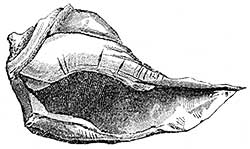
|
| Fig. 5. Conch Shell |
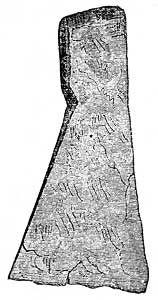
|
| Fig. 6. Axe. |
"The pipe is imperfect. It is made of the earthenware of which so many specimens are found in the neighborhood, in the form of vessels and pipes. The spots where the manufacture of these articles was carried on are still to be seen in some places.
"The beads are formed of a white chalky substance, varying in degree of density and hardness; they are accurately circular, with a circular perforation in the centre; of different sizes, from a quarter to half an inch, or rather more, in diameter; but nearly all of the same thickness, not quite the eighth of an inch. They may be compared to a peppermint lozenge with a hole through the centre. They were found in bunches or strings, and a good many were still closely strung on a fibrous woody substance. The bracelet is a simple band of copper, an inch and a half broad, closely fitting the wrist. The hair is long, evidently that of a woman, and quite fresh in appearance.
"Another pit, about two miles from that just noticed, was also examined in September. It is considerably smaller, being not more than nine feet in diameter, by about the same original depth. It is situated on rising ground, in a light sandy soil, and there is nothing remarkable in its position. A beech-tree, six inches thick, grew from its centre. It contained about as many skeletons as the other pit, but had no kettles in it. The bones were of individuals of both sexes and of all ages. Among them were a few fetal bones. Many of the skulls bore marks of violence, leading to the belief that they were broken before burial. One was pierced by a round hole, like that produced by a musket ball. A single piece of a brass vessel was found in the pit; it had been packed in furs. A large number of shell beads, of various sizes, were also found here. Besides these, there were some cylindrical pieces of earthenware and porcelain or glass tubes, from an eighth to a quarter of an inch in diameter, and from a quarter to two inches long.15 The former had the appearance of red and white tobacco-pipes, worn away by friction, the latter of red and white glass. A hexagonal body, with flat ends, about an inch and a half in diameter, and an inch thick, was also found. It was composed of some kind of porcelain, of hard texture, nearly vitreous, and much variegated in color, with alternate layers of red, blue, and white. It was perforated through the centre.
"The third of these pits was examined in November, 1847. It is situated in the township of Oro, on elevated ground. The soil is a light sandy loam. It measures about fifteen feet in diameter, has the distinctly defined elevated ring, but the centre less depressed than in those before examined, which may have resulted from the greater bulk of its contents. On its margin grew formerly a large pine, the roots of which had penetrated through the pit in every direction. The bones, which were of all sizes, were scarcely covered with earth. The skeletons amounted to several hundreds in number, and were well preserved. On some, pieces of tendon still remained, and the joints of the small bones in some cases were unseparated. Some of the skulls bore marks of violence.
"As in the first noticed pit, so in this, were found twenty-six kettles—four of brass and the rest of copper, one conch-shell, one iron axe, and a number of the flat perforated shell beads. The kettles were arranged in the form of a cross through the centre of the pit, and in a row around the circumference. The points of this cross seem to have corresponded with the cardinal points of the compass. All except two of the kettles were placed with their mouths downwards. The shell was found under one of the kettles, which had been packed with beaver-skins and bark. The kettles were very well preserved, but had all been rendered useless by blows from a tomahawk. The holes were broken in the bases of the vessels. Should any doubt exist as to the purposes of these pits, the fact that the kettles were thus rendered unserviceable would tend to increase that doubt, as it appears to have been a proceeding so very contrary to the habits and ideas of the Indians in general.16
"A pipe was found in this pit, described as having been composed of blue limestone or hard clay. On one side it had a human face, the eyes of which were formed of white pearly beads. An iron axe and sundry beads were also found here.
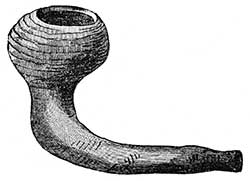
|
| Fig. 7. Clay pipe. |
"There is reason to believe that the above constitute but a very small proportion of the pits that may be found in this neighborhood. The French Canadians, now that their attention has been directed to the subject, say that they are of frequent occurrence in the woods. But besides these larger and more evident excavations, smaller ones of the same shape and apparent character are often met with. They are usually called 'potato-pits.' So far as they have been examined, they do not contain deposits. Some appear to have been covered with bark at the bottom. One was examined in which were found some pieces of pottery and one or two human bones mixed with stones and black mould; which seemed to strengthen the supposition previously formed, that they were Indian graves from which the bones had been removed for interment in the large pits.
"A fifth pit has also been examined. It occurs about eight miles from Penetanqueshene, near the centre of the town of Giny. Close by its side is another pit, which is not circular but elongated, with a mound on each side. At the brow of the hill, if it may be so called, and commencing about twenty yards from the pits, there is the appearance of a long ditch extending in a southwestern direction; another ditch about half the length of this meets it at right angles on the top of the rising ground, and is continued a few yards beyond the point of junction; a third ditch intersects the short one, as shown in the following plan.
"The two first ditches form two sides of a parallelogram; but there is no sign of an enclosure at the other sides, where the ground is low and nearly level. The long ditch is seventy-five paces in length, the other half that length. The first terminates at a moderate sized gum-tree, the latter at the foot of a large birch. These ditches appear to be a succession of small pits or graves, and have an average depth of from one to two feet. Excavation disclosed no bones. Upon the north side of the shorter and upper ditch, several Indian graves were found, not placed in any order, but scattered around at various distances apart. Three of these were examined and found to contain human bones. In one was an entire skeleton. No implements or ornaments accompanied the bones.
"The bones in the large pits were covered with three or four feet of earth, which is more than is usually found over them, and the marginal ring was in consequence less apparent. It contained very few relics besides the bones, which, from their decayed condition, seemed to indicate that burials here were made at a very remote period."
In Isle Ronde, situated near the extremity of Lake Huron, is a burial-place of the aborigines corresponding generally with those just described. It was visited in 1843 by Mr. Schoolcraft, who states that the human remains appeared to have been gathered from their original place of sepulture and finally deposited here. The bones were all arranged longitudinally, from north to south, in a wide grave or trench. There is upon the same island an Indian cemetery of comparatively modern date, in which the interments were made in the ordinary way. Another similar burial-place was visited by Mr. Schoolcraft, in the town of Hamilton, seventeen miles west of the head of Lake Ontario. The burials had been made on a high, dry ridge, in long trenches and rude vaults; the bones being piled upon each other longitudinally as at Isle Ronde. The trenches extend over the entire ridge; and one of these examined by Mr. Schoolcraft was estimated to include not less than fifteen hundred square feet. Various remains of art, pipes, shells, beads, etc., were found with the bones, and among them several brass kettles, in one of which were five infant skulls.
The origin of the various cemeteries above noticed admits of no doubt. The same practice which Bartram described as existing among the Floridians, and which we have reason to believe prevailed among the Indians of Tennessee, Kentucky, etc., also existed in a slightly modified form among the more northern tribes. They, too, had their solemn "Festival of the Dead," which is minutely described by Charlevoix, Brabeuf Creuxius, and other early writers. Says Charlevoix: "This grand ceremony, the most curious and celebrated of all connected with the Indian religion, took place every eight years among some of the tribes, every ten years among the Hurons and the Iroquois. It was called the 'Féto dos Morts,' Festival of the Dead, or ' Festin des Ames.'
"It commenced by the appointment of a place where they should meet. They then chose a president of the feast, whose duty it was to arrange every thing and send invitations to the neighboring villages. The appointed day arrived, all the Indians assembled and went in procession, two and two, to the cemetery. Among some tribes of stationary habits, the cemetery was a regular burial-ground outside the village. Some buried their dead at the foot of a tree, and others suspended them on scaffolds to dry; this last was a common proceeding among them when absent from home on a hunting expedition, so that on their return they might more conveniently carry the body with them.
"Arrived at the cemetery, they proceeded to search for the bodies; they then waited for some time to consider in silence a spectacle so capable of furnishing serious reflections. The women first interrupted the silence by cries of lamentation, which increased the feeling of grief with which each person seemed over- come. They then used to take the bodies, arrange the separate and dry bones, and place them in packets to carry on their shoulders. If any of the bodies were not entirely decomposed, they separated the flesh, washed the bones, and wrapped them in new beaver-skins. They then returned in the same procession in which they came, and each deposited his burden in his cabin. During the procession the women continued their lamentations, and the men testified the same marks of grief as on the death of the person whose bones they bore. This was followed by a feast in each house, in honor of the dead of the family. The succeeding days were considered as public days, and were spent in dancing, games, and combats, at which prizes were bestowed. From time to time they uttered certain cries, which were called 'les cris des âmes.'
"They made presents to strangers, and received presents from them on behalf of the dead. These strangers sometimes came a hundred and fifty leagues. They also took advantage of these occasions to treat on public affairs or select a chief Every thing passed with order, decency, and moderation; and every one seemed overcome with sentiments suitable to the occasion. Even the songs and dances expressed grief in some way. After some days thus spent, all went in procession to a grand council-room fitted for the occasion. They then suspended the bones and bodies in the same state as they had taken them from the cemetery, and placed there the presents intended for the dead. If among the skeletons there happened to be one of a chief, his successor gave a grand feast in his name. In some cases the bodies were paraded from village to village, and every where received with great demonstrations of grief and tenderness, and every where presents were made to them. They then took them to the spot designated as their final resting-place. All their ceremonies were accompanied with music, both instrumental and vocal, to which each marched in cadence.
"The last and common place of burial was a large pit, which was lined with the finest skins and any thing which they considered valuable. The presents destined for the dead were placed on one side; and when the procession arrived, each family arranged itself on a sort of scaffold around the pit; and as soon as the bodies were deposited, the women began again to cry and lament. Then all the assistants descended into the pit, and each person took a handful of earth, which he carefully preserved, supposing it would serve to give them success in their undertakings. The bodies and bones were arranged in order, and covered with furs and bark, over which were placed stones, wood, and earth. Each person then returned to his home, but the women used to go back from day to day with some sagamatie (pounded parched corn)." 17
13. Travels, p. 5l4.
14. Dr. Bern W. Budd, of New York, states that this shell, the pyrula perverse, abounds in the Gulf of Mexico and particularly in Mobile Bay. It has also been found by the officers of the U. S. Coast Survey as far north as Cape Fear, in North Carolina.
15. These were clearly the European imitations of the much prized Indian wampum.
16. Dr. Bawtree is mistaken in supposing this practice uncommon. The Oregon Indians invariably render useless every article deposited with their dead, so as to remove any temptation to a desecration of the grave which might otherwise exist. A similar practice prevailed among the Floridian Indians.
17. Charlevoix, Vol. II., p. 194, ubi supra; Creuxii Historia Canadensis, p. 97.


